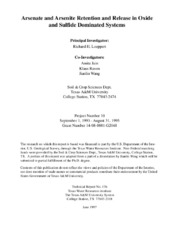| dc.description.abstract | Metal pollution of surface water resources in Texas is a significant problem, and is caused by the inflow of sediments from oil fields, old mines and industrial sites, and by the discharge of metal contaminated sewage and industrial effluents. In the preliminary phases of this project we were interested in a range of contaminant metals; however, following early experiments it was determined that emphasis would be given to arsenic due to the importance of several arsenic contaminated sites in east and central Texas. Three important general field and laboratory observations have been made concerning arsenic and have served as a basis for these studies: (1) correlations between metal concentrations of suspended solids or sediments (as measured by the recommended EPA and USGS methods) and metal levels in fish are often poor, (2) metal concentrations in pore waters of bottom sediments are often highly variable (with time and space) and often considerably higher (but sometimes lower) than in the overlying water column, (3) arsenic speciation and solubility are strongly influenced by redox potential. Existing EPA and USGS methods for quantifying the arsenic level of sediment or suspended solids primarily involve digestion by strong acids. While these methods do provide an indication of total concentration of metals, they often do not provide a reliable measure of bioavailability, either directly to aqueous animals or indirectly through the food chain. Inorganic arsenic exists primarily in the +3 or +5 oxidation states (depending on redox potential), and its reactions in soils and sediments are influenced by pH, redox potential, dissolved organic or inorganic components, and sediment colloids (especially Fe sulfides and Fe, Mn, and Al oxides and hydroxides) and organic matter. Arsenic is often concentrated at the surfaces of suspended and sediment colloids (as surface adsorbed and occluded species or possibly as poorly ordered solid solutions). Arsenic (+3 and +5) is bound, by ligand bonding mechanisms, at the surfaces of solid phase Fe, Al and Mn oxides, though there are major descrepencies in the literature concerning the relative bonding strengths of arsenate and arsenite. These reactions at colloidal surfaces strongly influence its availability within the biosphere in oxidized systems. Arsenic (+3) is readily precipitated as As2S3 or coprecipitated in the FeS2 or FeS structure, and these compounds often control the solubility of arsenic in low redox environments. Because of these reactions, arsenic is likely strongly influenced by the presence of inorganic sulfur.
The objectives of the study were as follows:
1. To characterize the concentrations and chemical forms of arsenic and the factors which influence its retention and release
2. To evaluate the role of the periodic oxidation/reduction processes that may occur in sediments on retention and release of arsenic
3. To evaluate the probable role of biologically induced processes (e.g., oxidation/reduction, acidification, and ligand exchange) which may influence the mobilization of precipitated or adsorbed arsenic
4. To develop surface dissolution procedures to assess heavy metal mobilization potential in sediments in the aquatic environment, with emphasis on calcareous stream bed sediments.
The primary benefit of this study will be to improve procedures for assessing the bioavailability and potential biological hazard of metals in suspended solids and sediments. Accomplishment of these objectives has enabled us to recommend procedures for assessing biohazard potential and ultimately to better monitor aquatic environments. | en |


